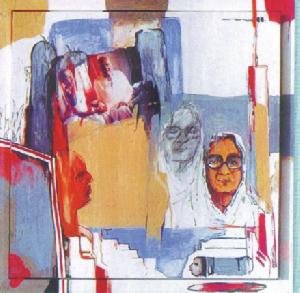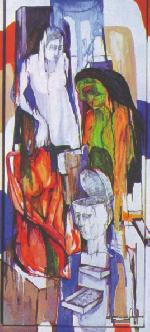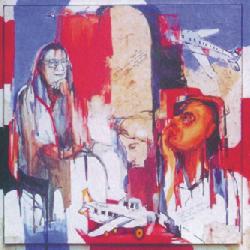| |
Modulation
of a Social Voice
Mustafa
Zaman
Modernist
in mode and illustrational in subject matter, this line
may be enough to sum up the recent works the artist Fareha
Zeba. But to do justice to her whole oeuvre that she amassed
in the solo show titled 'Sufia Kamal, an Introspection'
at the Gallery Chitrak, one must progress towards elaboration.
Zeba puts enormous emphasis on two things. One is colour
and the other is human motif. Her development as an artist
who is craving to find a firm footing on the artistic turf
is a recent one. She is an artist with a freshly developed
expressionistic style. Her deviation is a recent phenomenon,
she used to draw differently few years back. The motif--the
human motifs mostly--that now adorn her paintings (done
on ply board with acrylic) are of recent yield.
Regarding colour, she is bound to a set of hues: blue, gray,
rust and muddy yellow, black and white. The whole picture,
in fact, is painted on white background in every occasion.

Twilight
Magic, 2002
Her human figures are tortuous, dehumanised and intentionally
sketchy, sometimes even maladroit. Which lend them an awkward
articulation. This articulation, somehow, escaped the notice
of the creator, otherwise she would not be prone, to the
degree she is, to the depiction of the portraitures of public
personalities.
Fareha Zeba incorporated, in most of her paintings, the
portraits of historically and nationally prominent liberal
bigwigs, specially poet and activist Sufia Kamal. These
glimpses of icons, she incorporates in her figurative forays,
and she also paints pictures where her icons are her only
muse. Yet her painting is neither glorification of these
figures nor painted as historical documents or mere prtraiture.
The artist used them as plain popular elements, her works
that includes the icons, are at best be described as paintings
that illustrate an allegiance of the artist with the figures
who stand for liberal causes.

Mirror
of Life-1, 2002
As the title of the show suggests, it is the portrait of
the late poet and activist Sufia kamal that dominates as
subject. Ghandi and Sheikh Mujibur rahman, too, are present
in a couple of works. Her whole show seems to rotate on
the theme of the portraits of Sufia Kamal. She is present
as an icon, not as a leader of the masses. Zeba declares
her faith in the late poet by depicting her in many ways
and in many sequence, but she does not go further to touch
upon the social context that made Sufia Kamal the icon of
the middle class. Most of the celebrated figures are out
of context in her pictures. Out of context because the social
figures are present as illustrations--as visual elements--in
her visual imageries.
Though she adds, in some pictures, a photo of a procession
or scribbles that appropriates the news of the Mahila Parishad
meeting or other news clips, her works cannot forcefully
exteriorise the historical background that made them what
they are. They are remote from the context, as such far
removed from the social and political brew that they were
a part of. And this certainly is the reason why this artist
put forward such innocuous imageries in the series that
uses the icons. Whereas the same artist is ready to whip
up the smack of angst and sarcasm in at least few of the
works. These few works are bereft of any iconic humans.
Sad, morbid looking humans inhabit these; chained animals
also figure in few occasions.
It is the Bangladeshi middle class liberal psyche that speaks
out in an awkward voice in most of the paintings of Fareha
Zeba. Awkward, because her rendition of humans almost verges
on the expressionistic, yet they do not complete their journey
to the extreme end. This brings into the surface the main
contradiction that marks the art of this artist. In the
work titled No-11, the main motif is the mildly expressionistic
statue of the Lady Liberty. But to her right at the bottom
the portrait of Sufia Kamal is framed inside an open window.
This arbitrary juxtaposition of two icons--one a human and
the other a statue--did not spring from either reason or
unreason, both could have lent a real artistic fervour to
this imagery. The portrait is present to assert the importance
of a figure that stood for social and political causes,
and the Lady liberty is her symbol. This analogy is dangerous
and unfounded. Had the artist reflected on the context of
the Lady Liberty, which no longer symbolises freedom, as
it is a symbol enforced on us by an imperialist nation.
What message does it send to the viewer when popular figures
and icons are used to emphasise issues of political import?
Or is it that the artist is just harping on our idolatry?
If the social and political message is what she wants to
impart, putting the portraits as themes seem analogous to
the effort of trying to depict a hunting scene using the
visage of the hunter.
Fareha Zeba's art is trapped in the elitist cranium that
shows its social concern through allegiances with iconic
figures. She takes pleasure in the fact that she recognises
the force that changed the society, but she is utterly devoid
of real concern for anything social or political for that
matter.

Twilight
Magic 3, 2003
Her idea of idealism brought her closer the liberal canon,
but left her far removed from realities of the society and
of the painting. The reality of the society is in the struggle
of the masses or the plight of the middle class, or their
contribution in wining a war or superseding a predicament,
all these subject seem not to have bothered the artist.
Her paintings are a far cry from the real issues. As for
the reality of the painting, it is amply found in her tendency
to divide the white space into separate colour patches,
and putting humans of disparate sizes and even drawing few
morbid, leashed creatures leading their morbid owners who
are crawling the canvas edges defying gravitation. The artist
negotiated this reality for imposition of portraitures.
Not that Zeba's burgeoning style is exclusively her own,
not that it is even humanly possible to be that original.
Her human figures are derivative, they are beholden to the
works of Mahbubur Rahman and Saidul Haq Jwice, and many
other Indian artist in this connection. She is a belatedly
grown offshoot of that old figurative style.
Her illustration of illustrious humans as well as formal
arrangement of colour patches undermine her tendency towards
forging a figurative mode which is essentially anti elitist
in origin and in look. In the picture No-17 and 16 she is
free from the ghost of personality cult. But her formalism,
arrangement of colour patches against white background,
also play havoc with her stark expressionist mode. Her rigorous
display of colour patches antagonises her spontenious linear
style, which uses an abrasive language of art.
It is up to the artist to find the right voice. Fareha Zeba
either needs to cater to the liberal ideas and taste or
side with socially antagonistic mode, the choice is hers.
This Show was held from June-20-27,
2003. |



